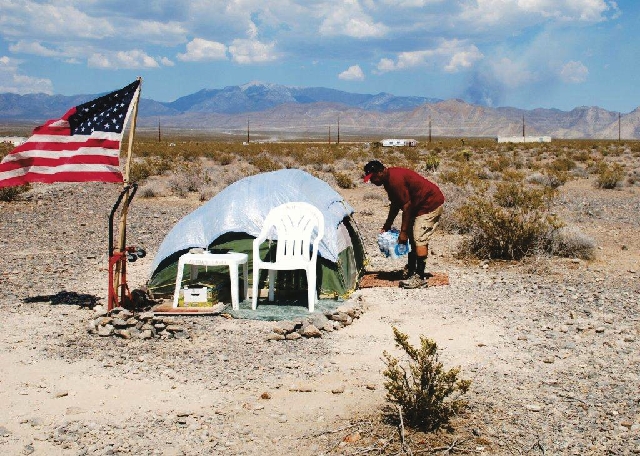
When daytime temperatures hit 115 degrees, as they have in our area, towns and cities across the Southwest, typically open public facilities to allow those without shelter a place to cool down.
Pahrump residents are finding no such luxury is available to them, unless walking around inside Walmart counts.
There are no central support facilities for those in greatest need, such as scattered desert dwellers or those who can’t afford air-conditioning. More than 30 percent of the local population falls below the poverty level, and the valley has a homeless rate of 8 percent.
The hospital is miles from the greatest need, leaving a stroll through area stores or the library the only recourse to get out of the heat. Most individuals coming into the emergency room either don’t have a cooled residence, or in some cases, a residence at all.
Desert View Hospital officials met recently to discuss heat-related issues and the concern that not enough is being done for people without adequate support. DVH cardiologist and hospital chief of staff Frederic Siegel confirmed that many individuals coming to the emergency room either don’t have an air conditioner or don’t have one that is adequate in high temperatures.
“The town needs to be warned,” he said, adding that this is especially true for older residents. Not only are they older, but many use medications that could put them at increased risk in high heat.
“The elderly have a diminished sensation of thirst, therefore don’t have the warning system to drink more water when the body needs it. It’s a life and death issue,” he said.
Emergency room manager Sherry Cipollini said she’s noticed more treatments for dehydration.
“We’re seeing people who can’t afford adequate air-conditioning to keep body temperatures down. We give them IV fluids and electrolyte replacement infusions.”
Chief Nursing Officer Markeeta Araujo says it appears many people simply discover they are heat sick only after it’s an emergency.
“We’ve had an influx of people who are at higher levels of distress from being too hot. People seem to not know the symptoms and get in trouble fast.”
Cipollini emphasized that seniors and children are at the highest risk, though people who have consumed alcohol or taken drugs can also get caught unprepared.
“If a 6-year-old child says he or she has a headache, and it’s hot, this is a good sign that the child needs water, followed by a drink that will help bring up electrolytes.”
Tea or coffee, iced, or otherwise, is a diuretic and causes body fluid loss. Only water is emphasized by the medical team. DVH cardiologist and hospital chief of staff Frederic Siegel added, “It is vital that you discuss any medication change with your doctor. Don’t just stop taking a medication, like a water pill, under any circumstances without talking to your doctor.”
Pahrump town board members recently discussed the issue of water and cooling stations. According to one source, board member Harley Kulkin indicated the issue was “basically tabled because the town didn’t have funds for insurance if someone died at any cooling center they might set up.”
Town Manager Bill Kohbarger said in an email, trying to clarify what Kulkin might have meant, wrote that the town “didn’t have trained volunteers to man cooling centers, and a location couldn’t just be left open with water and ice for people to come and go.”
“The fire department cannot be utilized as a cooling station. The town does not have the manpower to allow individuals to stay within the fire station when the station is empty due to handling calls. The town has water as does the county to hand out to homeless veterans. In fact, the town did donate several cases of water to DAV (Disabled American Veterans) on Friday.”
The town manager cited lack of manpower as a reason for not simply opening the community center during the hottest parts of the day.
“The same issue applies there: lack of manpower. However, if there are certified volunteers that are willing to stay inside the Ruud Center (BRCC) with the homeless, then the town can possibly make it a cooling station. The town must also take into account those individuals, companies who have already reserved the BRCC for events.”
The one organization active in getting donations from local retailers is the Disabled American Veterans, Chapter 15 in Pahrump. Robert Ahrendt, adjutant for the group, said, “We are getting bottled water and ice from organizations like Sam’s Club, Home Depot, Walmart and others who provide gift cards we use to get water and other needs to those most in need.”
Bringing ice and water for those who need it most is done weekly by the DAV. Tyler Escalera, veteran volunteer, regularly takes water and ice to people living in the desert behind Smith’s Food & Drug and the Pahrump Nugget. He and others drive out to the various lean-to’s and shell-trailers, tents and even gutted trucks where people live.
One woman giving only her first name, Suzette, was happy for the water. The day it was delivered she had walked into town and back. She shaved her head in a bid to keep cooler.
A neighbor to someone living in a small tent was happy to have conversation but didn’t want his picture taken. He and his neighbor he refers to as “Desert Delight Dewite” rely on the DAV support. He said, “I would never have a family out here, but I manage.”